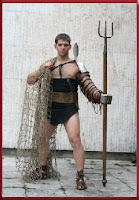Who were THE GLADIATORS?
Gladiators were mostly slaves, convicted criminals or prisoners of war who were forced to fight. However, some free men did volunteer to be gladiators. Life in the Roman Empire could be tough, and although the path of a gladiator was very dangerous, at least men training in the gladiatorial schools were fed three square meals a day. Gladiators who fought well could become rich and famous, so volunteer gladiators dreamed of fame and fortune. Most gladiators fought in games three times a year.
Gladiatorial school
Gladiators trained to fight at gladiatorial schools. Teachers in the schools had often been gladiators themselves. New boys were tauhgt to attack straw men and were only allowed to use wooden-swords. All gladiators - even those who were volunteers- were kept chained together as if they were in prison.
Gladiators ate boiled beans and barley to build up their muscles.
At gladiatorial school anyone who broke the rules was several punished. but the food was good and gladiators were looked after by some of the most skilled doctors in the Roman Empire.
Gladiators trained to fight at gladiatorial schools. Teachers in the schools had often been gladiators themselves. New boys were tauhgt to attack straw men and were only allowed to use wooden-swords. All gladiators - even those who were volunteers- were kept chained together as if they were in prison.
Gladiators ate boiled beans and barley to build up their muscles.
At gladiatorial school anyone who broke the rules was several punished. but the food was good and gladiators were looked after by some of the most skilled doctors in the Roman Empire.
Who is who in the arena?
There were many different types of gladiator. Some were well-armed and others fought nearly naked. The murmillo and the thraex, who often fought one another, were heavyweight gladiators who wore similar helmets and carried swords and shields. You can tell the difference between them because the thraex has a smaller shield and a griffon crest on his helmet.
The retiarius was armed with a net, a dagger and a trident, and was lightweight and fast on his feet. The retiarius often fought the secutor, who was much more heavily armed, but who found it hard to see throught the small, round eye-holes in his helmet. The secutor's helmet had no crest. Gladiators fought to a strict set of rules. If the gladiators broke the rules a referee could step in and stop the fight.
Can you work out which gladiator is which? Look at what sort of armour they are wearing and what weapons they are carrying.
Answer the questions:
1- Who mostly were the gladiators?
2- Could a free man be a gladiator?
3- Was there any advantages in being a gladiator?
4- Could a gladiator became rich?
5- How many times did gladiators fight a year?
6- How many different types of gladiator were there? Can you remember their names?
7- Where were the gladiators trained to fight?
8- How were they kept not to escape?
9- Which did the gladiators eat?



